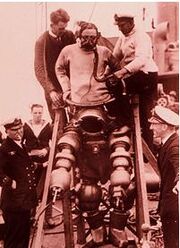
Men and women have practiced breath-hold diving for centuries. Indirect evidence comes from thousand-year-old undersea artifacts found on land (e.g., mother-of-pearl ornaments), and depictions of divers in ancient drawings. In ancient Greece breath-hold divers are known to have hunted for sponges and engaged in military exploits. Of the latter, the story of Scyllis (sometimes spelled Scyllias; about 500 BC) is perhaps the most famous. As told by the 5th century BC historian Herodotus (and quoted in numerous modern texts).
16th century[]
In 16th century England and France, full diving suits made of leather were used to depths of 60 ft. Air was pumped down from the surface with the aid of manual pumps. Soon helmets were made of metal to withstand even greater water pressure and divers went deeper. By the 1830s the surface-supplied air helmet was perfected well enough to allow extensive salvage work.
19th Century[]
Starting in the 19th century, two main avenues of investigation - one scientific, the other technologic - greatly accelerated underwater exploration. Scientific research was advanced by the work of Paul Bert and John Scott Haldane, from France and Scotland, respectively. Their studies helped explain effects of water pressure on the body, and also define safe limits for compressed air diving. At the same time, improvements in technology - compressed air pumps, carbon dioxide scrubbers, regulators, etc., made it possible for people to stay under water for long periods.
Early Diving Equipment[]
Ancient swimmers used cut hollow reeds to breathe air, the first rudimentary snorkel used to enhance our abilities underwater. Around 1300, Persian divers were making rudimentary eye goggles from the thinly sliced and polished shells of tortoises. By the 16th century, wooden barrels were used as primitive diving bells, and for the first time divers could travel underwater with more than one breath of air, but not much more than one.
Impact []
Emile Gagnan and Jacques Cousteau co-invented the modern demand regulator and an improved autonomous diving suit. In 1942, the team redesigned a car regulator and invented a demand regulator that would automatically fresh air when a diver breathed. A year later in 1943, Cousteau and Gagnan began selling the Aqua-Lung.
Breathing Under Water[]
In 1771, British engineer, John Smeaton invented the air pump. A hose was connected between the air pump and the diving barrel, allowing air to be pumped to the diver. In 1772, Frenchmen, Sieur Freminet invented a rebreathing device that recycled the exhaled air from inside of the barrel, this was the first self-contained air device. Freminet's invention was a poor one, the inventor died from lack of oxygen after being in his own device for twenty minutes.
In 1825, English inventor, William James designed another self-contained breather, a cylindrical iron "belt" attached to a copper helmet. The belt held about 450 psi of air, enough for a seven-minute dive.
In 1876, Englishmen, Henry Fleuss invented a closed circuit, oxygen rebreather. His invention was originally intended to be used in the repair of an iron door of a flooded ship's chamber. Fleuss then decided to use his invention for a thirty-foot deep dive underwater. He died from the pure oxygen; oxygen is toxic to humans under pressure.